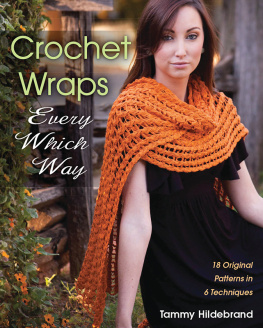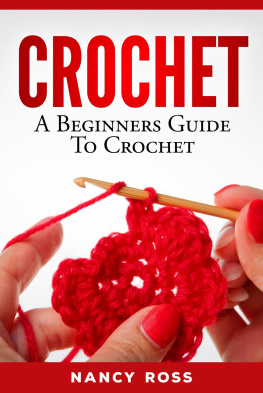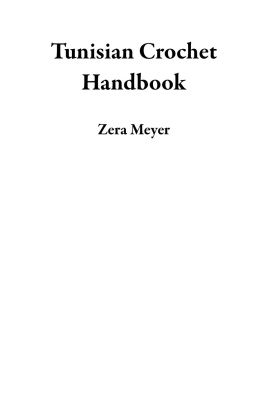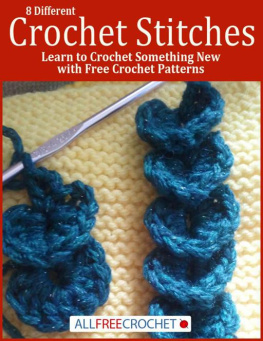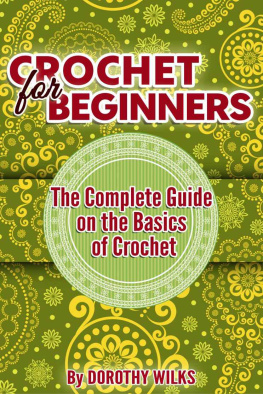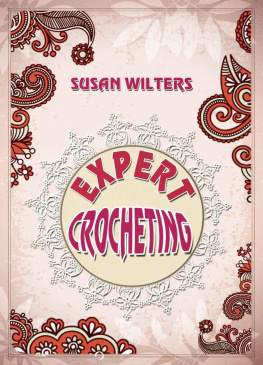Chapter One The Right Equipment
Before we begin youll need some basic equipment. Thisincludes crochet hooks, shears, stitch markers, a row counter, and a bag ortote to store your yarn, works in progress, and equipment. You dont need tospend a fortune on good quality equipment. A nice set of aluminum crochethooks, a good pair of shears, and some simple stitch markers are all you reallyneed to get started. In this chapter well cover the basic equipment youllneed and the proper way to use it.
Crochet Hooks
Crochet hooks come in various sizes from very small almostneedle like hooks used with thread to huge hooks used to create rugs. For thebeginner I recommend purchasing a good quality hook set with sized from US E toUS K. These will be the sizes used for most patterns for all skill levels. Youcan find hooks with comfort grips if you have problems with arthritis orholding a hook. You can also make your own grips with clay. Some of the othermaterials used for hooks include steel, bamboo, various woods, and plastic. Agood quality set of aluminum hooks are perfect for the beginner, and will serveyou for many years.


A crochet hook is pretty straight forward. Most hooks have anindentation in the handle called the grip or pad that you use to grip the hook.There are two basic types of lips and thread guides. Boye hooks have a morerounded thread guide while Bates hooks are more angular. Which type of hook youuse is purely personal preference. Ive used both types and really cant tellmuch difference in them. But some diehard fans swear by their favorite brand,so check them out and see which ones you prefer.
As you advance in your skills you may want to try outTunisian crochet. This type of crochet uses a long hook to hold the stitches.It looks very similar to a long knitting needle with a crochet hook on one end.You can also find Tunisian crochet hooks with a long piece of plastic or metalused to hold many stitches. These look similar to circular knitting needleswith a hook on one end. Circular Tunisian crochet hooks are used for very largeprojects such as a kind size afghan. You can also find double ended crochethooks. These are used for more advance techniques similar to Tunisian crochet.
Crochet Hook Sizes
Crochet hooks come in many sizes. As I mentioned before steelhooks with very small hook sizes are used for delicate thread and lace work.Steel hooks are sized differently than other hooks. When using steel hooks youmust remember that the higher the number the smaller the hook, for example thelargest hook size is 00 while the smallest is size 14.
Most patterns use crochet hook sizes from US E/4 (3.5mm) toUS K/10.5 (6.5mm). Patterns use both the letter size and the millimeter size.Use this handy chart from the Craft Yarn Council to refer to the various hooksizes. This chart is also a handy reference if you find patterns not written inUS terminology.

How to Hold a Crochet Hook
There are two camps of thought when it comes to holding acrochet hook. One is the pencil hold and one is the knife hold. As the namesimply if you use a pencil hold youll hold your hook like a pencil. If you usea knife hold you will hold your hook like you would a table knife. Bothtechniques are correct, and both techniques produce the exact same stitches.Which hold you use is up to you. Try them both out and see which one feels bestto you. Personally Ive always held my hook like a pencil. That is how mymother and grandmother taught me. But Mikey from The Crochet Crowd uses theknife hold in all of his video tutorials, but we both end up with the samefinished product. So dont let anyone tell you that you hold your hook wrong.Either way is fine; just do what feels natural to you.

In this image you cansee the hook is held like a knife.

This image shows thehook held like a pencil.
Stitch Markers

Stitch markers are used to mark the beginning of a patternrepeat, the beginning of a round when crocheting in the round, and colorchanges. There are many different types and styles of stitch markers you canfind from simple plastic clip on ones to ornate beaded ones. You might evenwant to try your hand at making your own stitch markers with safety pins andbeads. Ive even used a bobby pin in a pinch, or a contrasting piece of yarn asa stitch marker. Just be sure to use stitch markers that are removable so thatyou dont crochet them into your work.
Other Equipment for Beginners
You will need a pair of scissor (shears) which you only usefor cutting yarn, thread, and fabric. Let everyone in your family know theseshears are hands-off and only for your crochet work. This keeps them nice andsharp. Cutting paper will dull shears and when you go to use them youll noticea big difference in how they cut.
A row counter is another handy little tool to have. You useit to keep track of which row you are on in your pattern. Many patterns haverow repeats to achieve the proper look. You can find row counters in manydifferent styles. You can even use a piece of paper and a pencil to keep trackof your rows by writing down the row numbers or using hash marks.
You will also want to purchase a bag or tote to store yourcrochet supplies. This will keep your projects away from curious little handsor paws. I have cats and I have to keep my yarn, supplies, and works inprogress in a covered tote. My cats love to explore boxes and bags so I neededsomething with a locking top to keep them out of everything. As you expand youryarn stash and skills you may want to get some sturdy shelving to organize yourcrochet supplies. I dream of turning my guest room into a craft room and Imalways on Pinterest looking at the many ideas. A girl can dream right?


